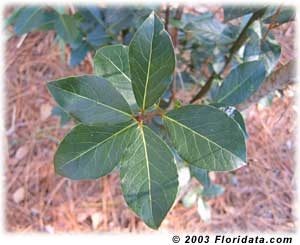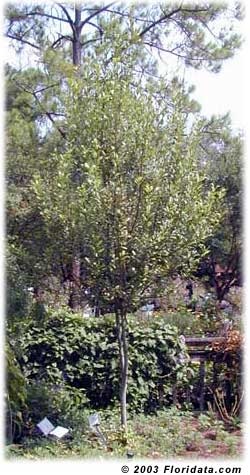Laurus
nobilis
Common
Names: bay laurel, bay, bay leaf, laurel, sweet bay
Family:
Lauraceae (laurel Family)
Description
Bay
laurel is a pyramid-shaped tree or large shrub with aromatic, evergreen
leaves and shiny gray bark. It can reach 60 ft (18.3 m) in height in
its native range, but generally is much smaller, 3-10 ft (0.9-3.1 m)
tall. in culture. Bay laurel sometimes produces suckers from the base.
The leaves are elliptic, 3-4 in (7.6-10.2 cm) long, rather thick and
leathery, and shiny dark green. Clusters of small yellow flowers are
produced in spring, followed, on the female plants, by shiny black or
purple berries about 0.5 in (1.3 cm) long.
Several cultivars have been selected, including: 'Aurea', with
yellowish young foliage; 'Angustifolia' (also called willow-leaf bay),
with narrow lance-shaped leaves; and 'Undulata' with wavy leaf margins.

Fig. 1
The leaves of the bay laurel are the chef's
bay leaves and an important ingredient in many savory dishes
Location
Bay laurel,
Laurus
nobilis, is native to the southern Mediterranean region.
It is grown commercially for its aromatic leaves in Turkey, Algeria,
Morocco, Portugal, Spain, Italy, France, and Mexico.
Culture
Light:
Bay laurel grows best in partial shade.
Moisture:
Water when dry. Bay laurel thrives with frequent watering in rich,
well-drained soil.
Hardiness:
USDA Zones 8 - 10.
Propagation:
Bay laurel seeds are slow to germinate and often rot before they do.
Cuttings taken from semi-hard, green tip shoots in summer will root in
6-9 months if they don't rot first.
Usage
Where hardy, grow bay laurel in a woodland garden or as a specimen.
Protect from cold winter winds. Bay laurel is an excellent shrub for
hedges and a favorite for topiary sculpture because it responds very
well to pruning. It can be trained as a standard or allowed to grow as
a spreading shrub. In cooler regions, grow in a container and bring
indoors in winter.
The popular culinary seasoning, bay leaf, is used extensively in
French, Italian, Spanish and Creole cooking. It flavors soups, stews,
shellfish boils, pickling brines, sauces, marinades, and poultry and
fish dishes. Always remove the bay leaves before serving, because they
are sharp and can cut the mouth and throat. French chefs place bay
leaves, parsley and thyme in a little bundle called a bouquet garni
that is removed after cooking. Pick bay leaves early in the day and dry
quickly under weight so they won't curl. Store in an air-tight jar.
Features
Bay laurel is the true laurel of Greek and Roman mythology. A poet
laureate is an
accomplished poet, and the Roman poet, Ovid, retold the story of the
Greek nymph, Daphne, who was transformed into a laurel tree by her
father, Peneus, so that she could avoid the amorous pursuit of the god,
Apollo. (Cupid had shot an arrow into the fair maiden's heart so that
she would not love Apollo.) Thereafter, Apollo wore a wreath of laurel
to show his love for Daphne. Laurel has always symbolized victory and
merit, and a baccalaureate (
baca
lauri, Latin for "laurel berry") still is a symbol of
accomplishment. Bay laurel has been credited with magical properties,
like protecting from witches, the devil and lightning.

Fig. 2
Bay laurel is the perfect small tree for patios and can be grown in container in climates where it is not hardy
The leaves and berries of bay laurel contain the essential oils
eugenol, cineol and geraniol, which account for the distinctive spicy
aroma. Infusions are reputed to soothe the stomach and relieve
flatulence. An oil pressed from the berries was once a popular liniment
for arthritis and sore muscles, and still is used in perfumes, candles
and soaps.
In the US northwest, the leaves of California bay (
Umbellularia californica)
are substituted for bay leaves in recipes, and in the southeast, red
bay (
Persea borbonia)
leaves are an acceptable substitute. In India, "bay leaf" refers to the
cassia tree (
Cinnamomum
cassia). All three of these are in the laurel family. In
the West Indies, "bay leaf" refers to the bay rum tree (
Pimenta racemosa),
in the Myrtaceae. Note that the unrelated mountain laurel (
Kalmia latifolia),
in the Ericaceae, has poisonous leaves.
Warning
Some people get an allergic reaction from contact with the foliage or
the essential oils of bay laurel. Do not place bay leaves in your mouth
- they can cut.

